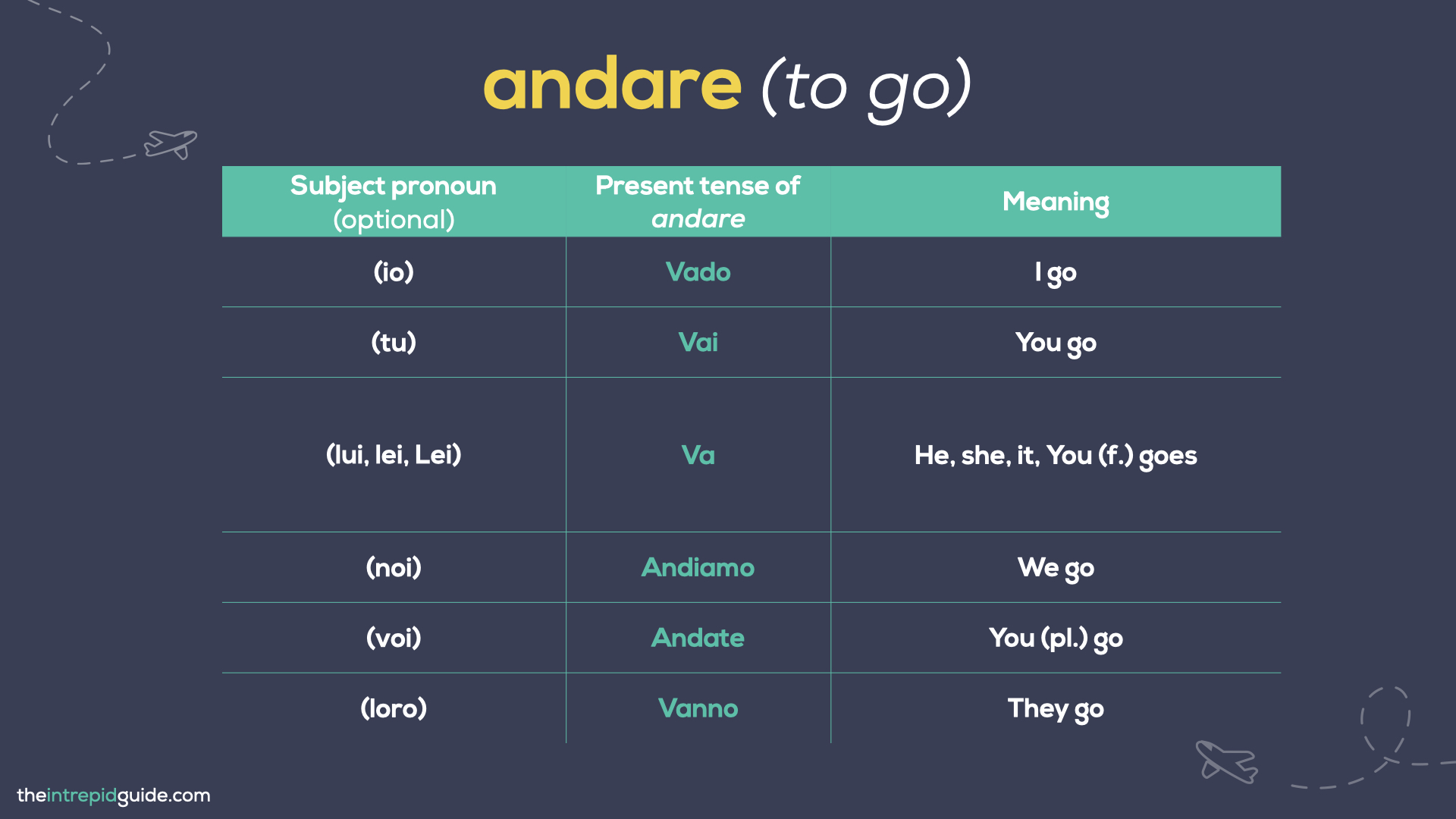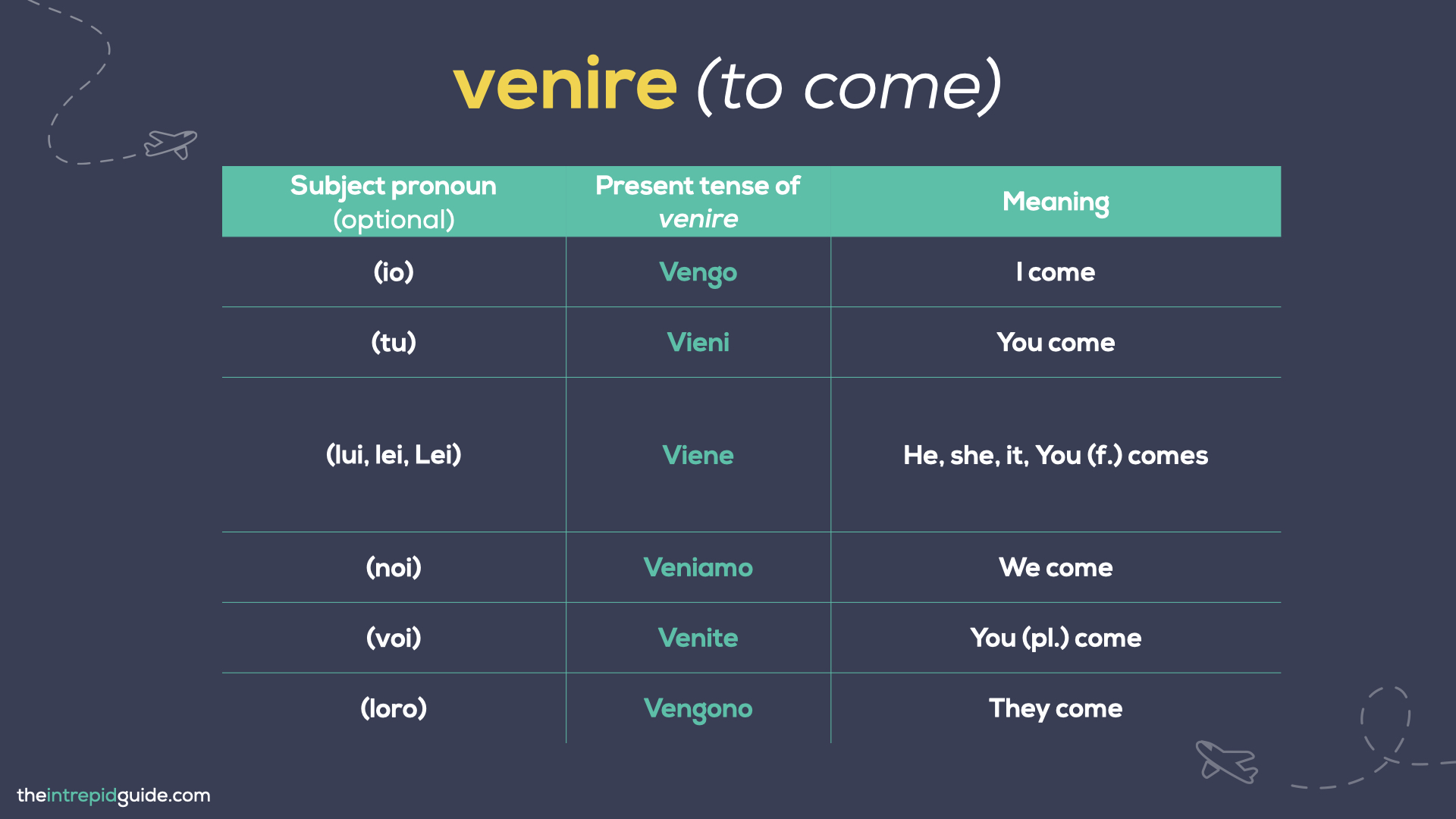Are you coming or going? To know for sure, you’ll need to know the two most common Italian verbs which indicate movement from and towards a place. These verb are: andare and venire. Even though their meaning seems pretty straightforward on a theoretical level, many students of Italian have difficulties using them.
In this guide, I’m going to explain everything you need to know about using andare and venire so you never mix them up again! We’ll take a look at how they’re conjugated in the present tense (both of which are irregular), their meaning, and a few typical idiomatic expressions that Italians use in everyday conversation. There’s even a fun little quiz at the end so you can test your skills!
Iniziamo! (Let’s begin!)
What is the difference between ANDARE and VENIRE?

The short answer is: andare means ‘to go’ while venire means ‘to come.’ But there are some important differences you should know about. Let’s take a look!
*Tip: For a list of common Italian verbs, get my free guide here. It includes a FREE PDF cheat sheet you can download and practice with.
The Italian verb ANDARE: to go
Let’s start with the verb andare. This verb indicates a movement towards a place, which is far away from the people who you are talking to. Imagine a friend says to you:
Domani vado in montagna con la mia famiglia. (Tomorrow I’m going to the mountains with my family.)
First, we have to understand one key thing: where our friend is and where we are. Maybe we are sitting together in a café, or maybe we are talking on the phone and they are in Rome while I am in London. In any case, we are both far from the place our friend is talking about: la montagna.
So, we use andare when the movement is towards a place that is both far from me and who I’m talking to.
How to conjugate the verb ANDARE

Here is the conjugation of andare in the present tense.
| Verb conjugation | English translation | |
|---|---|---|
| (io) | Vado | I go |
| (tu) | Vai | You go |
| (lui, lei, Lei) | Va | He, she, it, You (f.) go(es) |
| (noi) | Andiamo | We go |
| (voi) | Andate | You (pl.) go |
| (loro) | Vanno | They go |
To form the passato prossimo (past tense) of andare we need its past participle: andato.
Find out more about how to easily conjugate Italian verbs here or watch my video below.
Prepositions that go with ANDARE and example sentences
The verb andare can be used with different prepositions. Unfortunately, in Italian, there is no hard and fast rule about which preposition follows the verb andare: the preposition used depends on the noun.
For instance, if andare is followed by a country or street address, the preposition in has to be used, For example:
- Vado in Canada il mese prossimo (I’m going to Canada next month)
- Questa sera andiamo in via Verdi (tonight we’re going to Verdi street).
On the other hand, with cities and towns, we use the preposition a, e.g. quando vai a Parigi? (when are you going to Paris?). Here are some of the most common phrases formed by andare + a preposition + a noun.
- Andare al mare (going to the sea)
- Andare in vacanza (going on vacation/holiday)
- Andare a scuola (going to school)
- Andare al bar (going to the café)
- Andare al cinema (going to the cinema)
- Andare a teatro (going to the theater)
- Andare in biblioteca (going to the library)
- Andare dal dottore / da + persona (going to the doctor / to someone’s)
- Andare in farmacia (going to the pharmacy)
Another very common structure is: andare followed by the preposition a plus a verb in the infinitive mode, e.g. vado a fare una passeggiata (I’m going to take a walk).
Other example sentences with andare include:
- Mi piacerebbe andare in Australia. (I would like to go to Australia.)
- Dove andate in vacanza quest’estate? (Where are you guys going on holiday this summer?)
- Andiamo a mangiare una pizza? (Shall we go eat pizza?)
Notice how in all these cases, the place we are going to is far from the speaker and listener?
Idiomatic expressions with ANDARE
Let’s look at typical phrases with andare:
- Andare sul sicuro: it means ‘to play it safe’, to make a simple choice that is risk-free, to avoid unforeseen consequences. For example: per il compleanno di Sara, se vuoi andare sul sicuro, regalale un profumo (for Sara’s birthday, if you want to play it safe, give her a perfume).
- (Non) mi va di… : it means ‘I (don’t) feel like (doing something)’. It combines the indirect pronoun, the verb andare in the 3rd person singular and di + infinitive. For example: oggi non mi va di uscire (I don’t feel like going out tonight). It is also very common in the form of a question to suggest doing something or ask someone if they’re up/down for something, e.g. ti va di andare al cinema? (would you like to go to the cinema?)
- Andare matto/a per: it means to love something, to be crazy about something (a food, an activity, an interest, etc.). For example: vado matta per la pasta alla carbonara (I go crazy for pasta alla carbonara).
The Italian verb VENIRE: to come
Let’s move on to venire. Generally speaking, the verb venire indicates the origin of something or someone. In this case, it is always used with the preposition da. You might be familiar with the popular question beginners learn: da dove vieni? (where are you from?); and a typical response: vengo da Londra (I’m from London).
The phrase venire da indicates any movement from a place, but not necessarily a geographic origin. For instance:
- Vengo dalla palestra, per questo indosso ancora la tuta (I’m coming from the gym, that’s why I’m still wearing a tracksuit).
In addition to this meaning, venire, just like andare, indicates a movement towards a place. The difference, however, is that in this place there is now (or will soon be) at least one of the people involved in the conversation and we use venire to indicate a movement towards the person who is/will be there. If a friend asks us:
- Vieni anche tu in montagna? – Are you also coming to the mountains?
He/She is asking us if we are going to the mountains and we know for sure he/she will be there too.
Venire is often used with the expressions con me/te/noi (with me/you/us) etc., or anche tu/io (you also/you too) etc., thus indicating one person joining other people in a place.
How to conjugate the verb VENIRE

Here is the conjugation of venire in the present tense.
| Verb conjugation | English translation | |
|---|---|---|
| (io) | Vengo | I come |
| (tu) | Vieni | You come |
| (lui, lei, Lei) | Viene | He, she, it, You (f.) come(s) |
| (noi) | Veniamo | We come |
| (voi) | Venite | You (pl.) come |
| (loro) | Vengono | They come |
The past participle of venire, which we need to form the past tense (passato prossimo) is regular: venuto.
Prepositions that go with VENIRE and example sentences
We can easily replace andare with venire in all the examples we saw earlier and even use the same prepositions. The difference is that, when using venire, we’re implying that the person(s) we’re talking to, is/are or will be there!
Let’s look at the following example phrases:
- Ho avuto un imprevisto, non vengo con voi a teatro, mi dispiace. (Something came up, I won’t come to the theatre with you (all), I’m sorry.)
- Ragazzi, venite al bar? Siamo tutti là. (Guys, are you coming to the bar? We’re all going to be there.)
- Quando vieni in Italia? (When are you coming to Italy? → meaning: I’m already in Italy)
Notice how in all these examples, venire is used with the meaning of joining someone in a place.
We can also replace andare with venire in the structure with the preposition a + infinitive. For instance: non vengo a mangiare la pizza stasera, meaning that our friend is going to eat pizza tonight but I’m not going with him/her.
Idiomatic expressions with VENIRE
Let’s look at typical idiomatic expressions with venire:
- Venire al mondo: this means nascere, ‘to be born’, ‘to come into the world’. For example: il piccolo Leonardo è venuto al mondo la scorsa notte (little Leonardo came into the world last night).
- Venire al dunque: it means ‘to come/get to the point’. For example: Marco, è da mezz’ora che stai parlando, vieni al dunque (Marco, you’ve been talking for half an hour, get to the point).
- (Non) venire in mente (a qualcuno): it means ‘(not) to remember something’ or ‘(not) to come to mind’. This phrase is formed by an indirect pronoun, the verb venire in the third person (singular or plural, according to the noun that it refers to), plus in mente. For example: non mi viene in mente il titolo di quella canzone (I can’t remember the title of that song); quando vedo Giorgio, mi vengono in mente tutte le nostre avventure insieme (when I see Giorgio, all our adventures together come to mind).
So, the difference between between these verbs is that we use andare when the movement is away from the people we’re talking to, and we use venire when the movement is toward the place where one of the people talking is located!
Hai capito? (Do you understand?) Now test yourself by taking my free quiz below. Read the sentences and choose which verb is more appropriate to use, andare or venire. Share your score in the comments!
 Are you a beginner or an intermediate Italian learner? Got a trip coming up or want to communicate with your Italian partner or relatives in Italian? Learn Italian with my unique 80/20 method
Are you a beginner or an intermediate Italian learner? Got a trip coming up or want to communicate with your Italian partner or relatives in Italian? Learn Italian with my unique 80/20 method
Registrations are now open to join Intrepid Italian, my new series of online video courses that use my unique 80/20 method. You’ll go from a shy, confused beginner to a proficient and confident intermediate speaker, with me as your trusty guide.
You’ll finally be able to connect with your Italian partner, speak to your relatives and enjoy authentic travel experiences in Italy like you’ve always dreamed of, and so much more.
As a native English speaker who learned Italian as an adult, I know what it’s like to feel hopeless and lack the confidence to speak. I know what it’s like to start from scratch and to even go back to absolute basics and learn what a verb is!
Intrepid Italian was created with YOU in mind. I use my working knowledge of the English language to help you get into the ‘Italian mindset’ so you can avoid the common pitfalls and errors English speakers make – because I made them once too! I break everything down in such a way that it ‘clicks’ and just makes sense.
No matter what your level is, there is an Intrepid Italian course for you, including:
- 🇮🇹 Intrepid Italian for Beginners (A1)
- 🇮🇹 Intrepid Italian for Advanced Beginners (A2)
- 🇮🇹 Intrepid Italian for Intermediates (B1)
You can join 1, 2, or all 3 courses, it’s entirely up to you. The best part is that you have lifetime access so you learn anytime, anywhere and on any device.
As your guide, I walk you through each lesson, step-by-step, using my unique 80/20 method. My approach is different from traditional methods because I teach you the most important 20% of the language right from the beginning so you can start to speak straight away.
Each course includes video lessons, audio exercises, downloadable worksheets, bonus guides, a private support community, and lifetime access all designed to streamline your learning while having fun.
It even comes with my famous “Celebrate with a Spritz Guarantee”. After 30 days of using Intrepid Italian, if you don’t want to celebrate your new-found Italian skills with an Aperol Spritz, you don’t have to pay a penny! Cheers! 🥂
Join Intrepid Italian here and start learning today!
Ci vediamo lì! (See you there!)
Like it? Pin it for later!

Learning Italian? Don’t miss these Italian language guides
- What is your level in Italian? Find out with this FREE quiz!
- What is the best way to learn Italian? Here’s how I did it!
- How to Conjugate Italian Verbs in 3 Simple Steps [Italian for Beginners]
- 15 Italian Words You Should NEVER Mispronounce [& How Not To]
- Italian Numbers: How to Count in Italian From 0 to 1 Billion (Plus PDF Download)
- Master Days of the Week in Italian (7 Simple Memory Hacks)
- How to Order Food & Drinks in Italian [Italian for Beginners]
- Is Italian Hard to Learn? 7 Common Mistakes & How to Avoid Them
- 41 Italian Greetings: How to Say ‘Hello’ in Italian Like a Local
- 11 Effective Hacks That’ll Help You Learn Italian So Much Faster
- Top 14 Italian Words You Should NEVER Say [& What to Use Instead]
- 20 Hilarious Everyday Italian Expressions You Should Use
- Romanesco: 25 Cool Roman Dialect Words You Should Use in Rome
- 10 Reasons Why Learning Italian Will Change Your Life
- How to Learn Italian Before Your Trip
- 10 Italian Expressions Italians Love Saying
- Italian for Beginners | 8 DEADLY Mistakes in Italian (& How to Avoid Them)
- 10 Italian Phrases That Will Instantly Make You Sound more Italian
- Funny Italian Sayings: 26 Food-Related Insults You Won’t Forget
- 15 Romantic Italian Films That’ll Make You Love Italy Even More
- How to Master Common Italian Phrases for Travel (Like a Local!)
Over to you!
Did you find this guide useful? What other verbs do you mix up in Italian? Let me know using the comments section below or join me on social media to start a conversation.
Thanks for reading and I hope you enjoyed this post.
Like what you see? Subscribe using the form below to have all of my posts delivered directly to your email

